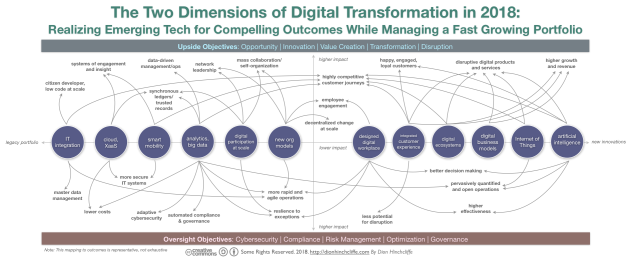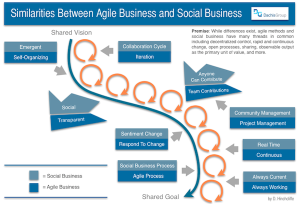Digital Transformation in 2018: Sustainably Delivering on the Promise at Scale
January 5, 2018 2 Comments
In 2017, we witnessed organizations take up the mantle of digital transformation with more conviction and effort than any time before. Funding, commitment, and leadership support was at its highest level ever and only showed signs of increased dedication. Ongoing success stories from many leading organizations showed that large scale technological and business transition was also possible for the typical company, not just industry leaders. Perhaps most vitally, the imperative itself became even clearer to leaders as disruption began to penetrate even into long resistant industries like healthcare, finance, and even insurance.
Yet it was also evident that last year was another major learning year, because through our efforts many of us gained an even fuller appreciation of the sheer size and scope of the required journey ahead of us. Combined this with the steady proliferation of new and important technologies last year and we gained both fresh urgency and a better understanding of the true challenges facing us. In 2017, the Internet of Things and artificial intelligence were felt particularly profoundly on the transformation agenda in the industry, along with data science, analytics, and other forms of capitalizing on the vast and invaluable streams of new information that better digitized businesses generate. 2018 will see the same, but with much more focus on reaching the market effectively and seizing network effect, and less on experimentation.
Of all the many lessons learned on digital transformation last year, perhaps the most important was that the complexity and pervasiveness of the necessary changes — organizational, cultural, and especially mindset — as well as the new technologies themselves require powerful new tools and techniques that simply didn’t exist a couple of years ago.
The Twin Digital Transformation Lessons of 2017
Two of these new tools and techniques — culled from the hard won experience of the early movers in digital transformation — are particularly worthy of calling out.
The first was a result of the realization that a single, overly centralized change entity like the IT department, the digital line of business (usually led by the chief digital officer), or tech incubator was not sufficient in realizing the profound rethinking and realization of the entire organization in more digital terms. In fact, these entities might not even be that helpful in that they are overly focused on technology and may not have the requisite experience in applying to the redesign and transformation of the business itself. Instead, more decentralized yet highly engaged entities like empowered groups of change agents or networks of transformation teams seem to be more effective are driving long-term change both deeply and widely across the organization. This evidence is backed up by careful research last year by Professor Gerald Kane and his colleagues that digitally mature companies are more likely to have impactful enterprise-wide transformation efforts.
The second insight was that the raw building blocks for digital transformation that existed were simply too primitive, not situated for business use, too little informed by the vital patterns and practices now known to be necessary, and not designed to rapidly incorporate new technology and additional lessons learned as they emerged. In the past, we would have said we needed frameworks for digital transformation, and while those emerged as well, what we really needed was much more operational constructs that had these vital ingredients: A relatively complete cloud tech stack, workable blueprints for specific industries, architectures designed for high leverage that support rapid change, and business solutions crafted to a 40-60% level of completeness and waiting for the details of your business to fill in the rest. While Amazon Web Services, Microsoft Azure, and Google Cloud provided some of these building blocks, they simply weren’t complete on their own. Organizations such as SAP (with its Leonardo offering), Accenture, and others have thus created what I’ve called digital transformation target platforms, which are more mature, complete, and business-focused transformation vehicles and operational capabilities. Note: For more details, you can find a fuller explanation and list of such enabling target platforms on my recent shortlist.
Combined, these two lessons learned — which are equally balanced between the people equation and the technology challenges — are vital in my analysis to successfully tackle the digital change obstacles and opportunities at sufficient speed and scale. That’s because there are very significant competitive implications — that would be irrelevance and/or outright disruption — to moving too slowly or tackling digital change too narrowly and in silos.
The good news in my experience over the last year: More and more organizations are now indeed staring to find these onramps to the superhighway of much more rapid and effective digital transformation. Enough now so that it’s led to a second major — and steadily growing — issue that must itself now be managed as a top priority new purview. This quickly accumulating new tech and business portfolio which comes from achieving a higher change velocity must be well-managed and governed. We simply must keep our new digital businesses secure in an age of Meltdown and Spectre as well as complying with GDPR and all the other rapidly emerging digital regulations that threaten to impede our efforts.
The Two Dimensions of Digital Transformation in 2018
As we’ve emerged from the very early days of digitization, there is now a clearer sense of how to tie emerging technologies to specific outcomes. A generic example of such a map is shown above, depicting how technologies can combine and reinforce key desired outcomes ranging from data-driven management of the business and better employee engagement to satisfied customers and higher growth and revenue, while also optimizing the results, governing it all, and keeping everything running safely and securely. These outcomes can be broken down today into two different key dimensions.
The first dimension of digital transformation outcomes, what I call the upside objectives, is what most organizations have been mostly focused on until now, as they try to get out of the gate to create initial wins. You can see from the accompanying visual above, that technology does indeed define the art-of-the-possible when it comes to disruptive new products and services (blue circles, center.) While lightweight IT integration, cloud, analytics, architectures of participation, and smart mobility have been technology approaches we’ve had for a while, the modern focus on digital transformation tends to be today on building and wielding customer-facing experiences infused with digital business models, interconnected ecosystems, services built on top of the Internet of Things, and with many flavors of artificial intelligence to make it personal and differentiated. Even the digital workplace is seeing fairly comprehensive overhauls in many organizations precisely to provide the tools and environment for workers en masse to be more effective at transforming their part of the organization. As a result, low code tools, citizen developer, personalized digital workplaces, hackathons, and other ways of spreading out the hands-on transformation process to the edges of the organization to move more quickly are a focus here.
The second dimension of digital transformation outcomes, let’s call it oversight objectives, is a newer one that hasn’t had nearly as much focus so far but is about to become very important as organizations digitally innovate faster and create far more complex ecosystems and stakeholder-facing experiences. Otherwise known as operations, governance, performance optimization, risk management, and cybersecurity, these oversight capabilities must get better and scale just as much as the upside portion of the portfolio. To ensure these capabilities are funded and resourced just as well as the other side of the digital transformation coin is going to be one of the next big challenges.
The reality is that most legacy organizations are not structured or funded for delivering on continuous change as the norm, to do it sustainably, or at the scale required today. While we’re seeing next-generation organization models that will help, we’re all still learning a great deal about how to design the contemporary digital organization. That we simply have to figure it out is the reality for most of us, but the good news going into 2018 is that we have some promising avenues to explore for more successful results.
Additional Reading
In Digital Transformation, The Art-of-the-Possible and Average Practice Are Diverging
Digital Transformation and the Leadership Quandary
What’s really holding back today’s CIO from digital transformation?




























































